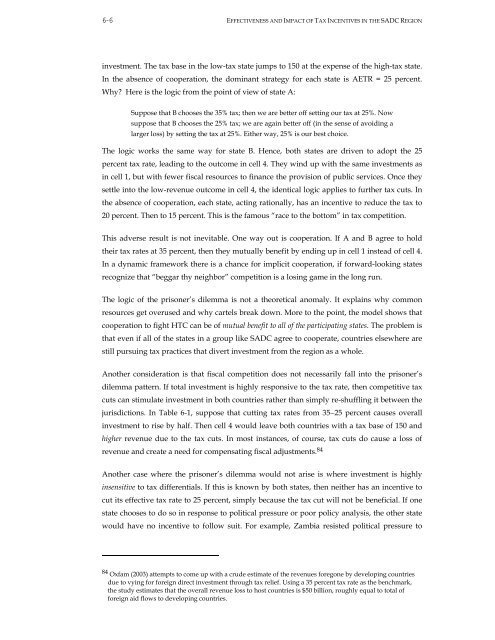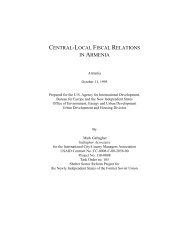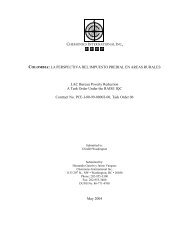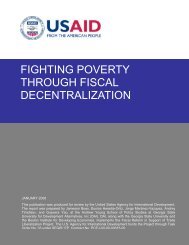Effectiveness and Economic Impact of Tax Incentives in the SADC ...
Effectiveness and Economic Impact of Tax Incentives in the SADC ...
Effectiveness and Economic Impact of Tax Incentives in the SADC ...
You also want an ePaper? Increase the reach of your titles
YUMPU automatically turns print PDFs into web optimized ePapers that Google loves.
6-6 EFFECTIVENESS AND IMPACT OF TAX INCENTIVES IN THE <strong>SADC</strong> REGION<br />
<strong>in</strong>vestment. The tax base <strong>in</strong> <strong>the</strong> low-tax state jumps to 150 at <strong>the</strong> expense <strong>of</strong> <strong>the</strong> high-tax state.<br />
In <strong>the</strong> absence <strong>of</strong> cooperation, <strong>the</strong> dom<strong>in</strong>ant strategy for each state is AETR = 25 percent.<br />
Why? Here is <strong>the</strong> logic from <strong>the</strong> po<strong>in</strong>t <strong>of</strong> view <strong>of</strong> state A:<br />
Suppose that B chooses <strong>the</strong> 35% tax; <strong>the</strong>n we are better <strong>of</strong>f sett<strong>in</strong>g our tax at 25%. Now<br />
suppose that B chooses <strong>the</strong> 25% tax; we are aga<strong>in</strong> better <strong>of</strong>f (<strong>in</strong> <strong>the</strong> sense <strong>of</strong> avoid<strong>in</strong>g a<br />
larger loss) by sett<strong>in</strong>g <strong>the</strong> tax at 25%. Ei<strong>the</strong>r way, 25% is our best choice.<br />
The logic works <strong>the</strong> same way for state B. Hence, both states are driven to adopt <strong>the</strong> 25<br />
percent tax rate, lead<strong>in</strong>g to <strong>the</strong> outcome <strong>in</strong> cell 4. They w<strong>in</strong>d up with <strong>the</strong> same <strong>in</strong>vestments as<br />
<strong>in</strong> cell 1, but with fewer fiscal resources to f<strong>in</strong>ance <strong>the</strong> provision <strong>of</strong> public services. Once <strong>the</strong>y<br />
settle <strong>in</strong>to <strong>the</strong> low-revenue outcome <strong>in</strong> cell 4, <strong>the</strong> identical logic applies to fur<strong>the</strong>r tax cuts. In<br />
<strong>the</strong> absence <strong>of</strong> cooperation, each state, act<strong>in</strong>g rationally, has an <strong>in</strong>centive to reduce <strong>the</strong> tax to<br />
20 percent. Then to 15 percent. This is <strong>the</strong> famous “race to <strong>the</strong> bottom” <strong>in</strong> tax competition.<br />
This adverse result is not <strong>in</strong>evitable. One way out is cooperation. If A <strong>and</strong> B agree to hold<br />
<strong>the</strong>ir tax rates at 35 percent, <strong>the</strong>n <strong>the</strong>y mutually benefit by end<strong>in</strong>g up <strong>in</strong> cell 1 <strong>in</strong>stead <strong>of</strong> cell 4.<br />
In a dynamic framework <strong>the</strong>re is a chance for implicit cooperation, if forward-look<strong>in</strong>g states<br />
recognize that “beggar thy neighbor” competition is a los<strong>in</strong>g game <strong>in</strong> <strong>the</strong> long run.<br />
The logic <strong>of</strong> <strong>the</strong> prisoner’s dilemma is not a <strong>the</strong>oretical anomaly. It expla<strong>in</strong>s why common<br />
resources get overused <strong>and</strong> why cartels break down. More to <strong>the</strong> po<strong>in</strong>t, <strong>the</strong> model shows that<br />
cooperation to fight HTC can be <strong>of</strong> mutual benefit to all <strong>of</strong> <strong>the</strong> participat<strong>in</strong>g states. The problem is<br />
that even if all <strong>of</strong> <strong>the</strong> states <strong>in</strong> a group like <strong>SADC</strong> agree to cooperate, countries elsewhere are<br />
still pursu<strong>in</strong>g tax practices that divert <strong>in</strong>vestment from <strong>the</strong> region as a whole.<br />
Ano<strong>the</strong>r consideration is that fiscal competition does not necessarily fall <strong>in</strong>to <strong>the</strong> prisoner’s<br />
dilemma pattern. If total <strong>in</strong>vestment is highly responsive to <strong>the</strong> tax rate, <strong>the</strong>n competitive tax<br />
cuts can stimulate <strong>in</strong>vestment <strong>in</strong> both countries ra<strong>the</strong>r than simply re-shuffl<strong>in</strong>g it between <strong>the</strong><br />
jurisdictions. In Table 6-1, suppose that cutt<strong>in</strong>g tax rates from 35−25 percent causes overall<br />
<strong>in</strong>vestment to rise by half. Then cell 4 would leave both countries with a tax base <strong>of</strong> 150 <strong>and</strong><br />
higher revenue due to <strong>the</strong> tax cuts. In most <strong>in</strong>stances, <strong>of</strong> course, tax cuts do cause a loss <strong>of</strong><br />
revenue <strong>and</strong> create a need for compensat<strong>in</strong>g fiscal adjustments. 84<br />
Ano<strong>the</strong>r case where <strong>the</strong> prisoner’s dilemma would not arise is where <strong>in</strong>vestment is highly<br />
<strong>in</strong>sensitive to tax differentials. If this is known by both states, <strong>the</strong>n nei<strong>the</strong>r has an <strong>in</strong>centive to<br />
cut its effective tax rate to 25 percent, simply because <strong>the</strong> tax cut will not be beneficial. If one<br />
state chooses to do so <strong>in</strong> response to political pressure or poor policy analysis, <strong>the</strong> o<strong>the</strong>r state<br />
would have no <strong>in</strong>centive to follow suit. For example, Zambia resisted political pressure to<br />
84 Oxfam (2003) attempts to come up with a crude estimate <strong>of</strong> <strong>the</strong> revenues foregone by develop<strong>in</strong>g countries<br />
due to vy<strong>in</strong>g for foreign direct <strong>in</strong>vestment through tax relief. Us<strong>in</strong>g a 35 percent tax rate as <strong>the</strong> benchmark,<br />
<strong>the</strong> study estimates that <strong>the</strong> overall revenue loss to host countries is $50 billion, roughly equal to total <strong>of</strong><br />
foreign aid flows to develop<strong>in</strong>g countries.











